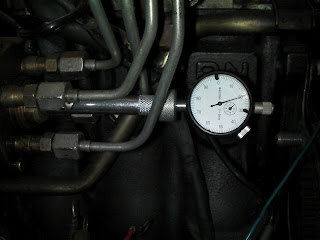EXHAUST
-Today the class and i looked at the falcon to check why the car is not idling properly.We found out that their was a leak by the manifold. The car was running to lean, so Hans sprayed some CRC so we could hear the leak and where it was coming from.
-We used the pressure gauge to force the pressure of the leak so we could hear where the problem is.
Petrol Emissions
-What could a really clean vehicle exhaust emission look like?
IDLE - 2500 RPM
HC- 1ppm - 5ppm
CO- 0.04% - 0.01%
CO2- 15.5- 15.4%
O2- 0.1%- 0.1%
-What could a RICH vehicle exhaust looks like?
IDLE
HC-148 ppm
CO-5.67%
CO2-11.3%
O2-0.2%
GLOW PLUG!
One big difference between a diesel engine and a gas engine is in the injection process. Most car engines use port injection or a carburetor. A port injection system injects fuel just prior to the intake stroke (outside the cylinder). A carburetor mixes air and fuel long before the air enters the cylinder. In a car engine, therefore, all of the fuel is loaded into the cylinder during the intake stroke and then compressed. The compression of the fuel/air mixture limits the compression ratio of the engine -- if it compresses the air too much, the fuel/air mixture spontaneously ignites and causes knocking. Because it causes excessive heat, knocking can damage the engine.
Today, in class we took out the glow plugs out and tested them to see if they were all working or not.They way we tested them is we put them on the bench and got a jumper pack, putting the negative one ground and the positive on the glow plug. after a few seconds the glow plug lit up and turned bright red as in photos.
If it does not glow then u would need to change your glow plugs, but another easier way to check your glow plugs is by using a voltmeter.

Diesel ignition timing (mechanically controlled injection)
Diesel engines ignite the fuel using the heat created by high compression (does not have spark plugs). The timing of the engine is controlled by the fuel injected into the cylinders if the fuel is injected to early the timing will be premature and if it is too late the timing will be retarded both resulting in a lack of power.
Experiment
We set the timing for a Mazda diesel engine. First we loosened the bolt, in the middle of the four high pressure lines that go to the injectors, on the diesel pump and put the DTI gauge in its place. Then we turned the crankshaft to 30 degrees before T.D.C and zeroed the Gauge. Then we turned the crankshaft to 2 degrees after T.D.C. We then loosened the diesel pump so that it was able to pivot, moved it so that the reading on the Gauge matched up with specifications and then tightened the diesel pump again. We removed the DTI gauge and replaced the bolt.
Reflection
The diesel pump from the engine we worked on is very similar to the distributor on most petrol engines as far as timing goes. The method we used is called static timing (engine is stationery

diesel engine: mode of operation
1. Suction stroke: Pure air gets sucked in by the piston sliding downward.
2. Compression stroke: The piston compresses the air above and uses therby work, performed by the crankshaft.
3. Power stroke: In the upper dead-center, the air is max. compressed: Pressure and Temperature are very high. Now the black injection pump injects heavy fuel in the hot air. By the high temperature the fuel gets ignited immediately (autoignition). The piston gets pressed downward and performes work to the crankshaft.
4. Expulsion stroke: The burned exhaust gases are ejected out of the cylinder through a second valve by the piston sliding upward again.
.jpg)
.jpg)
.jpg)
.jpg)
Hi Sepan
ReplyDeleteCan you separate your topics, first we connected the Exhaust gas analyzer, as a result we checked for a Vacuum leak in the manifold which we located by spraying CRC on the intake Manifold.
The Radiator pressure test was an entirely different lesson. Then you showed Gas test results, with no explanation.
You show a Glow plug but then explain the petrol engine fuel system.
Please come and discuss your post with me.
Hans